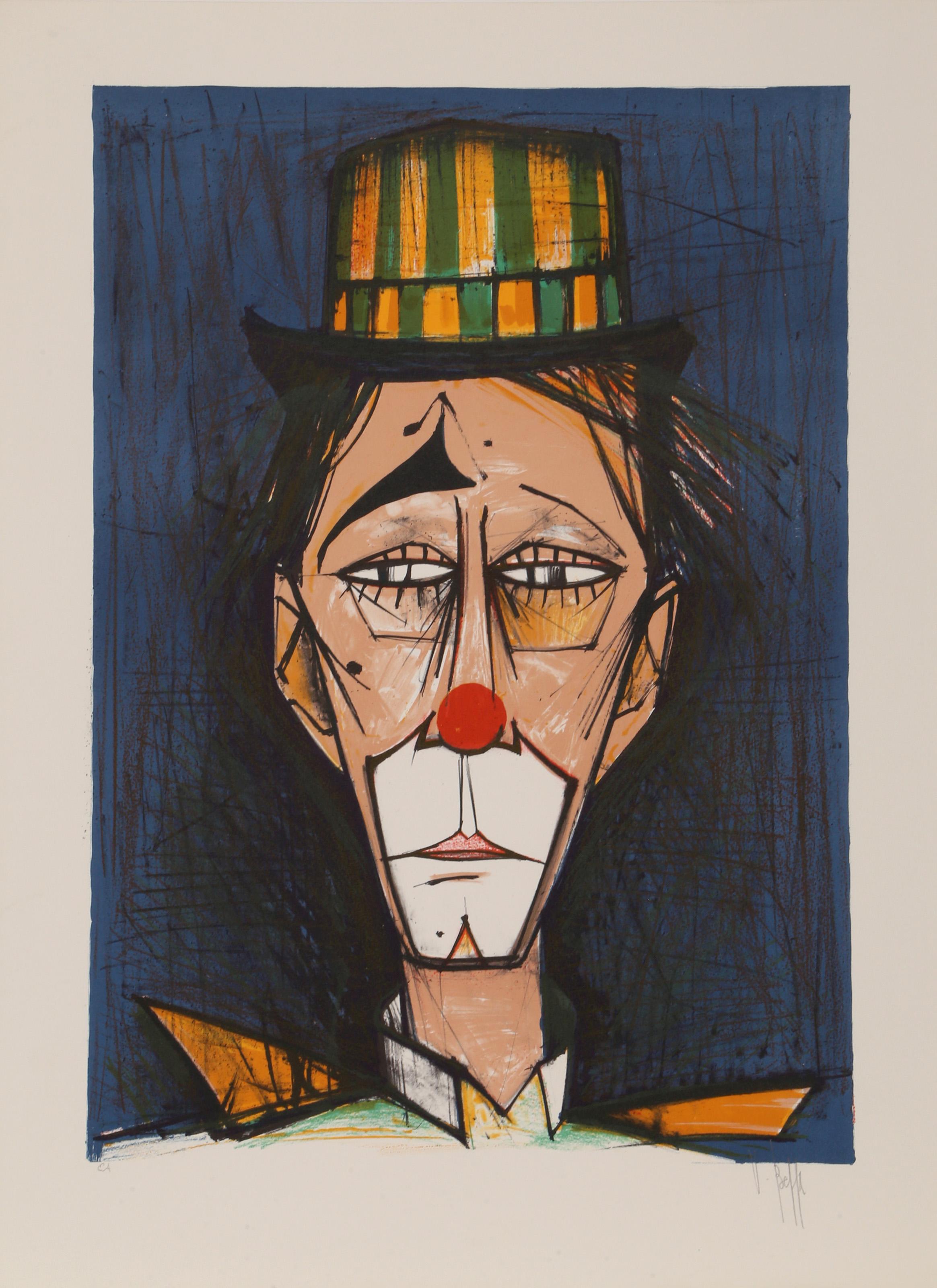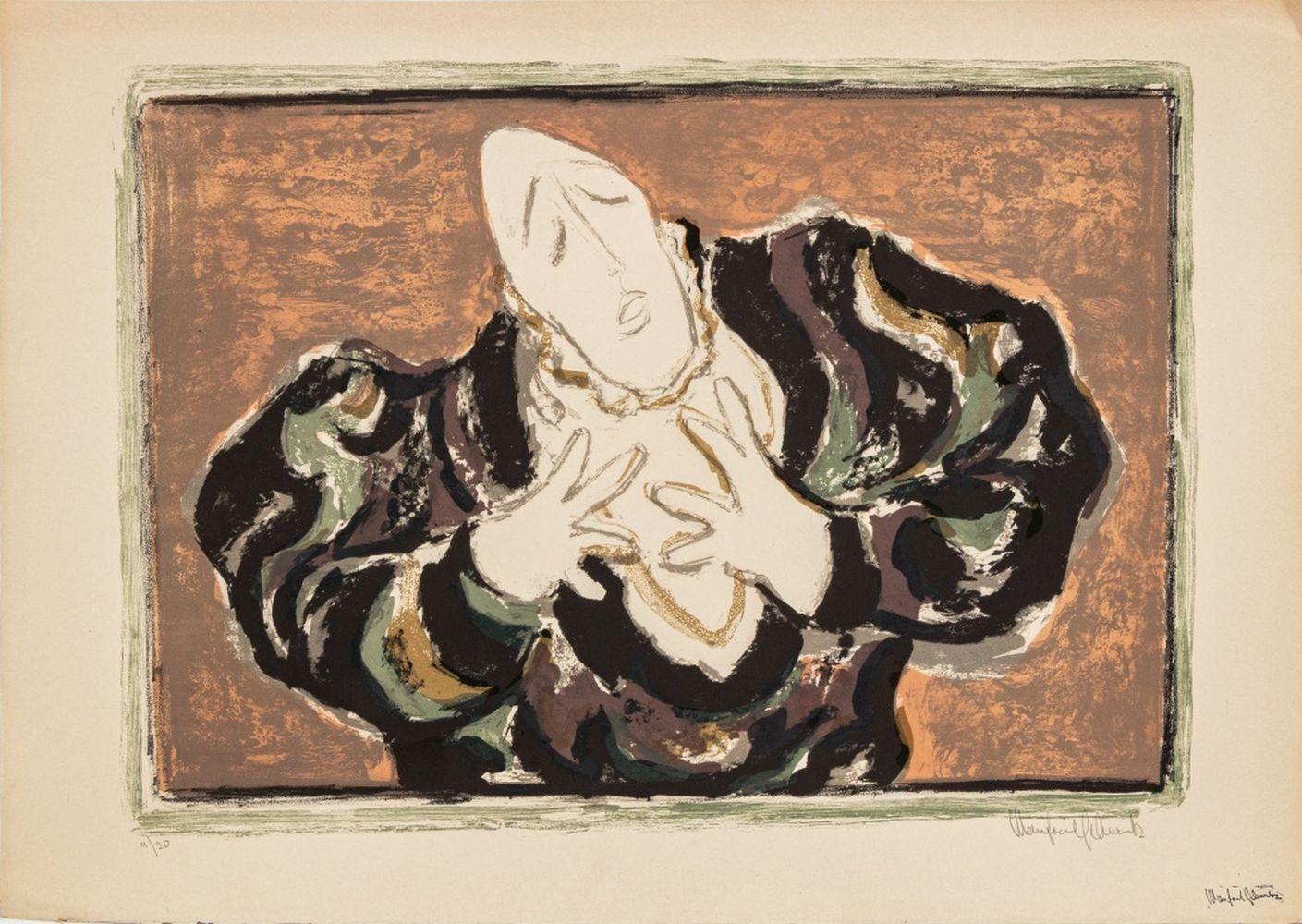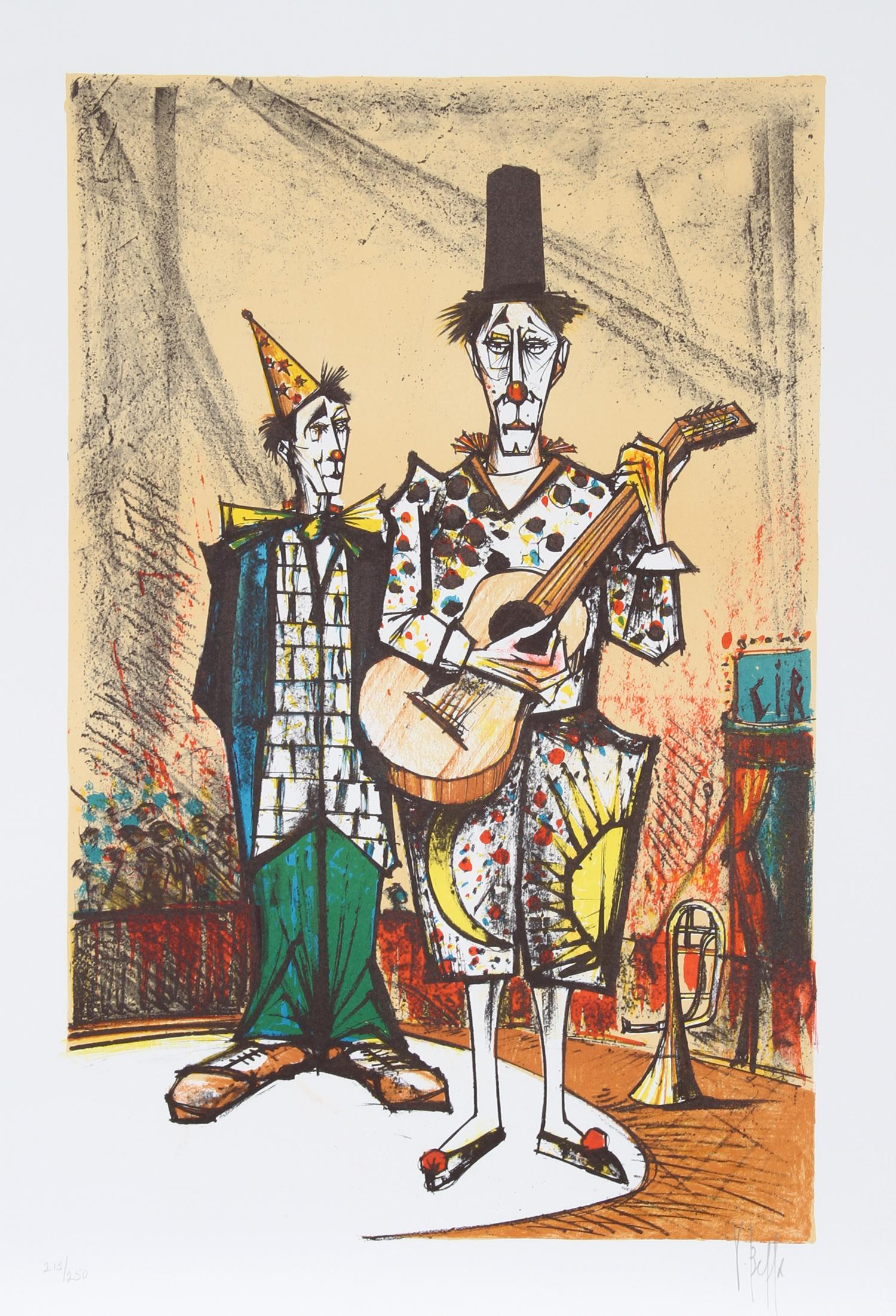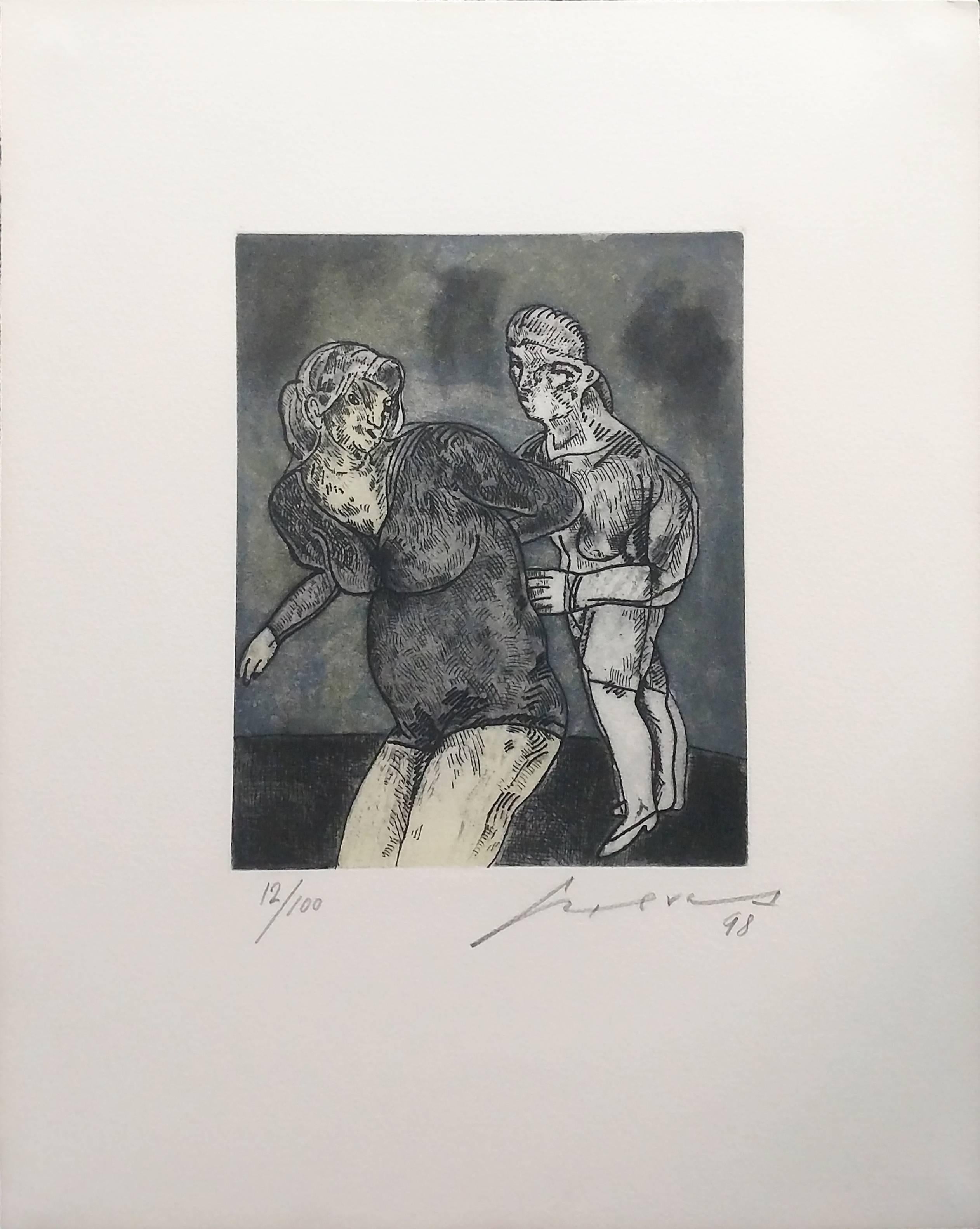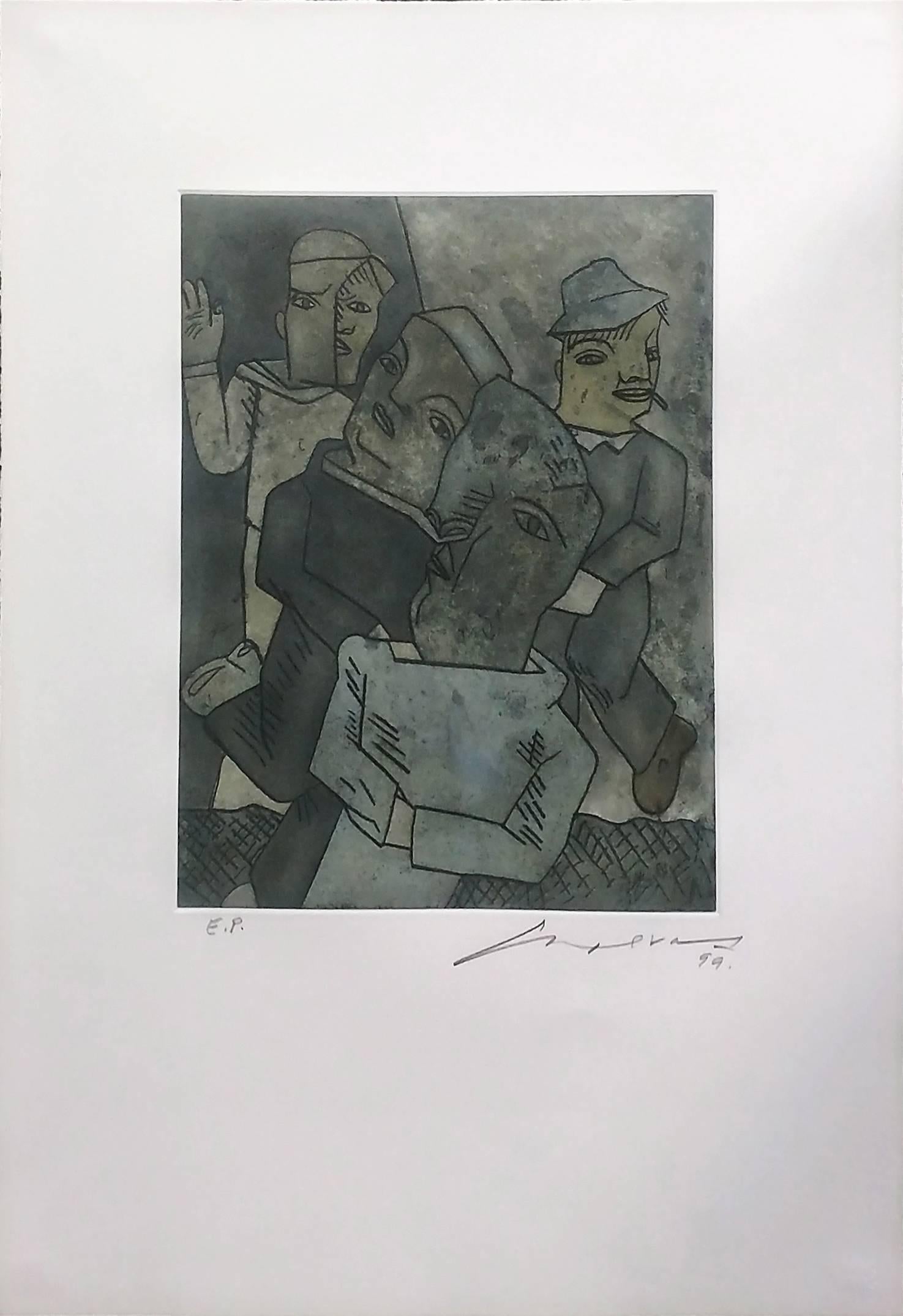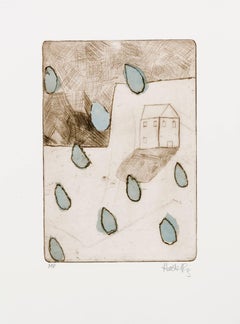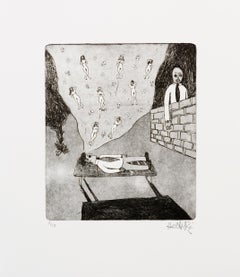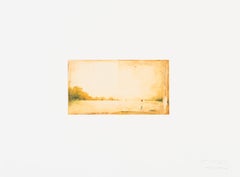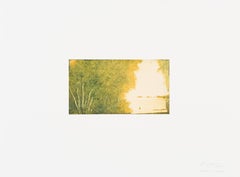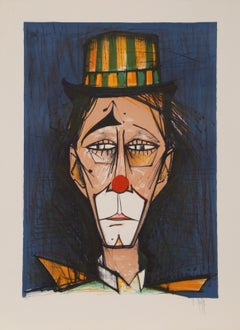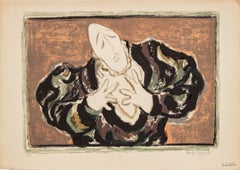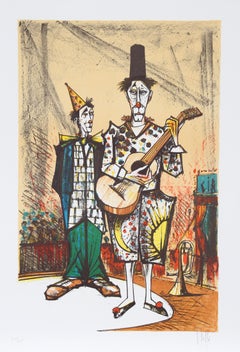Want more images or videos?
Request additional images or videos from the seller
1 of 5
Hector RuizBecoming the Clown2006
2006
$1,100
£846.33
€967.15
CA$1,574.36
A$1,716.81
CHF 901.89
MX$20,577.04
NOK 11,436.82
SEK 10,643.03
DKK 7,223.54
About the Item
Copper etching with aquatint
The power of memory and how it recalls individuality begins in such basic experiences as the ability to link internal ideas to external manifestations of those ideas. Memories as simple as an old toy or a street can set off a chain reaction of thoughts that snowball into issues as broad as nationalism, identity politics or a body politic to name a few. Hector Ruiz’s works encompass the broad, complex and often painful world particular to the Arizona and neighboring Mexican landscape. United States and Mexican border issues, immigration conflicts of gender and sexuality and urban development oblivious to the needs of the individual and the landscape create a combinative world that is seen through Ruiz’s own emotionally critical lens instead of through a universal one.
Having grown up in the border states of Texas and Arizona and spending many summers visiting family in Piedras Negras, Mexico, Ruiz consciously chooses to reside in Arizona because it is the most conservative of the border states. He prefers the conservatism because it is matched only by a rigorous activism that attempts to protect Mexican immigrants. Interminable debates of nation and rights are central to the life o any Arizonan. The fluidity of culture and peoples that are an effect of the border reinforce ongoing tensions such as nationalism versus cosmopolitanism, fragmentation versus unity, group mentalities versus individual ones and host of others.
Uncanny in its historical reflection, the same set of clashed existed in pre- and postwar Germany at the turn of the 20th century. A country faltering within its own fluid borders, its people felt their national, thus personal, identity slipping away in the face of internationalism, urbanism and industry. The vitality inherent to polarization, however, gave birth to the German Expressionist movement that became such a crucial facet of 20th century Modernism. Although late 19th and early 20th century Germany’s search for one nation/one identity is notably less complex than the United States’ Mexican border issues of today; there is a comparable rift in identity experienced by both Mexicans and Americans in addition to the difficulties that originate from the continuous social readjusting necessitated by globalization.
Lightly referencing many of the various schools and artists from the 30-some year period of German Expressionism, Ruiz draws a singular inspiration from the artist max Bachmann. Beckmann, the German Expressionist who defies many of his contemporaries with an insistent individuality, develops his own language through paintings and prints using tense, conflicted compositions, broad, black lines, and densely inhabited surfaces that bow with tension of their relationship to the two-dimensional background.
More contemporary artists who emerge in Beckmann’s wake also create fertile ground for Ruiz. In the late 1960’s and 1970’s, Phillip Guston’s strong, choppy lines and use of black as a color (in sushc a way that it is an unmistakable nod to Beckmann) makes way for his subject matter fo bodies, body parts and heads. In the 1980’s Jean-Michel Basquiat also make reference to both Beckmann and Guston, with his abundant use of bodies, body parts, animals, archetypal symbols, figures and densely packed surfaces.
Undoubtedly these influences transform into a hybrid mixture when seen in conjunction with 19th century Mexican political cartoonist Jose Guadelupe Posada’s works. Posada’s cartoons are ubiquitous stylistically and are still used in modes of Mexican popular art today. The cartoonish, raw, woodblock print style of skeletons lampooning reporters and political figures parallel the vision of the aforementioned artists who drive toward the truth at breakneck speed. Like his forebears, Ruiz uses truth as a weapon or tool employing the “ancient, traditional and deep-rooted foundations” of his Mexican, Native American and American background to wrench back the veil of over-development, the sterilizing effects of globalization and the havoc wreaked by border conflicts.
After graduating with a Bachelor of Fine Arts degree from Arizona State University in 1994, Ruiz quickly sought out alternative forms of art making and thought. He traveled extensively in India and asia, where he co-opted ancient spiritual texts such as the Bhagavad-Gita and forms of Buddhist thought to help lay the groundwork for ideas that have fueled his current work.
Woodcarvings and linoprints are his chosen mediums. Benefiting from the advantages of being self-taught in these skills, Ruiz’s woodcutting abilities concisely express his artistic intent. He is able to create and resource personal, visual statements and language through themes and repetitive images as well as make strong reference to craft in a way that transforms the strictures of ”folk” art into a forceful regional language.
- Creator:Hector Ruiz (American)
- Creation Year:2006
- Dimensions:Height: 18 in (45.72 cm)Width: 14.5 in (36.83 cm)
- More Editions & Sizes:1 x 10Price: $1,100
- Medium:
- Movement & Style:
- Period:
- Condition:
- Gallery Location:Phoenix, AZ
- Reference Number:Seller: 2006081581stDibs: LU13712994182
About the Seller
5.0
Vetted Professional Seller
Every seller passes strict standards for authenticity and reliability
Established in 1984
1stDibs seller since 2012
67 sales on 1stDibs
- ShippingRetrieving quote...Shipping from: Phoenix, AZ
- Return Policy
More From This Seller
View AllHomesick 4
By Hector Ruiz
Located in Phoenix, AZ
monoprint with drypoint and chine colle; unframed
image size: 10 x 7 inches
Category
Early 2000s Contemporary Prints and Multiples
Materials
Drypoint, Monoprint
Daybed Daydream
By Hector Ruiz
Located in Phoenix, AZ
copper etching with aquatint
The power of memory and how it recalls individuality begins in such basic experiences as the ability to link internal ideas to external manifestations of those ideas. Memories as simple as an old toy or a street can set off a chain reaction of thoughts that snowball into issues as broad as nationalism, identity politics or a body politic to name a few. Hector Ruiz’s works encompass the broad, complex and often painful world particular to the Arizona and neighboring Mexican landscape. United States and Mexican border...
Category
Early 2000s Outsider Art Figurative Prints
Materials
Copper
WOP 2 - 00642
By Hiro Yokose
Located in Phoenix, AZ
mixed media on paper; unframed
full sheet 22.5 x 30.25 inches
signed, dated and titled on lower right
Neoromantic painter Hiro Yokose fuses multiple layers of wax and oil paint ...
Category
2010s Romantic Abstract Drawings and Watercolors
Materials
Paint, Paper, Mixed Media, Archival Paper
WOP 2 - 00650
By Hiro Yokose
Located in Phoenix, AZ
mixed media on paper; unframed
full sheet 22.5 x 30.25 inches
signed, dated and titled on lower right
Neoromantic painter Hiro Yokose fuses multiple layers of wax and oil paint ...
Category
2010s Romantic Landscape Drawings and Watercolors
Materials
Paint, Paper, Mixed Media, Archival Paper
WOP 2 - 00669
By Hiro Yokose
Located in Phoenix, AZ
mixed media on paper; unframed
signed lower right
Neoromantic painter Hiro Yokose fuses multiple layers of wax and oil paint to create mysterious, veiled landscapes illuminated wi...
Category
2010s Color-Field Mixed Media
Materials
Paint, Paper, Mixed Media, Archival Paper
WOP 2 - 00639
By Hiro Yokose
Located in Phoenix, AZ
mixed media on paper; unframed
signed lower right
Neoromantic painter Hiro Yokose fuses multiple layers of wax and oil paint to create mysterious, veiled landscapes illuminated wi...
Category
2010s Romantic Abstract Drawings and Watercolors
Materials
Paper, Mixed Media, Oil
You May Also Like
Clown
By François Houtin
Located in Palm Springs, CA
Signed, titled and numbered in pencil, 32/40. an hommage to Giuseppe Arcimboldo, a 16th century artist best known for creating imaginative portrait heads made entirely of such objec...
Category
1970s Contemporary Figurative Prints
Materials
Etching
Clown, Modern Lithograph by V. Beffa
Located in Long Island City, NY
V. Beffa - Clown. Year: circa 1979, Medium: Lithograph, signed and numbered in pencil, Edition: 250, Size: 30 in. x 22 in. (76.2 cm x 55.88 cm)
Category
1970s Modern Portrait Prints
Materials
Lithograph
The Great Medrano Clown
By Manfred Schwartz
Located in Astoria, NY
Manfred Schwartz (American, b. Poland, 1909-1970), Great Medrano Clown, Lithograph on Paper, circa 1955, numbered edition "11/20" lower left, signed in pencil and with the artist's s...
Category
Mid-20th Century Modern Figurative Prints
Materials
Paper, Lithograph
Clowns, Modern Lithograph by V Beffa
Located in Long Island City, NY
Clowns
V. Beffa
Date: circa 1980
Lithograph, signed and numbered in pencil
Edition of 250
Image Size: 24.5 x 16 inches
Size: 29.5 in. x 22 in. (74.93 cm x 55.88 cm)
Category
1970s Modern Figurative Prints
Materials
Lithograph
UNKNOWN TITLE
By José Luis Cuevas
Located in Aventura, FL
Hand signed, dated and numbered by the artist. Edition of 100. Image size: 9.5 x 7.65 inches. Artwork is in excellent condition. Certificate of authenticity included. All reasonabl...
Category
21st Century and Contemporary Contemporary Figurative Prints
Materials
Etching, Paper
$1,500 Sale Price
50% Off
UNKNOWN TITLE
By José Luis Cuevas
Located in Aventura, FL
Hand signed, dated and numbered by the artist. EP edition. Image size: 11.75 x 8.75 inches. Artwork is in excellent condition. Certificate of authenticity included. All reasonable o...
Category
21st Century and Contemporary Contemporary Figurative Prints
Materials
Etching, Paper
$1,500 Sale Price
50% Off
More Ways To Browse
Privat Livemont
Rene Portocarrero
Renoir Drawings
Royal Albert Old Country Roses
Salvador Dali 1967
Salvador Dali Mythology
Sem Georges Goursat
Sonia Delaunay Pochoirs
Toyokuni Ii
Vermeer Lithograph
Vintage 1945 Dresses
Vintage Broadway Posters
Vintage Gun Print
William Auerbach Levy
William Lionel Wyllie
Woodcut Print Jacques
15th Century Woodcut
1978 Dali
